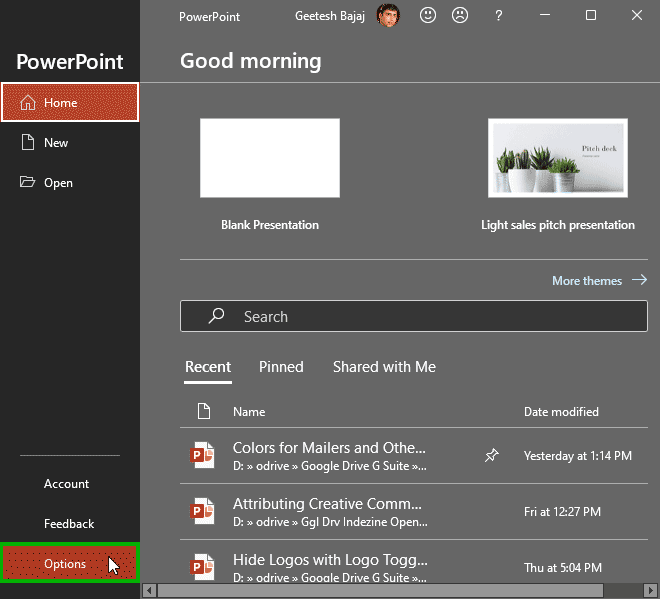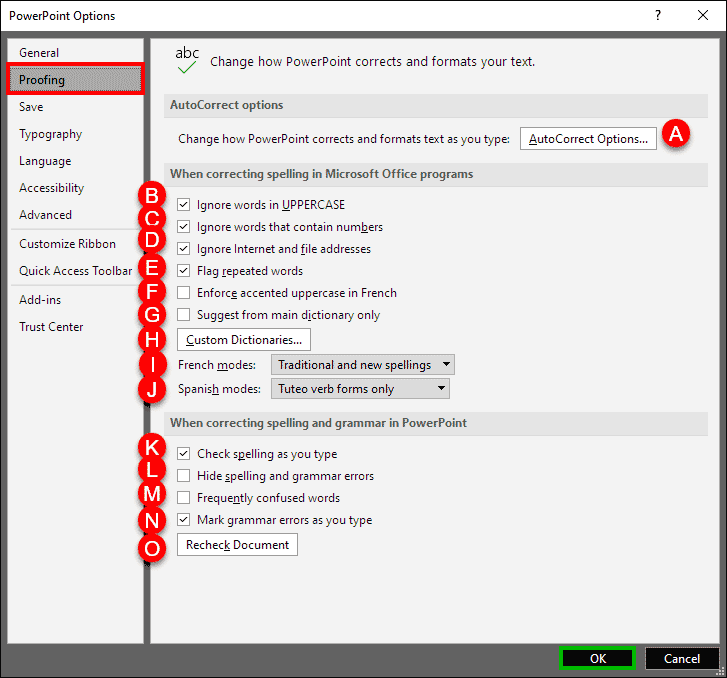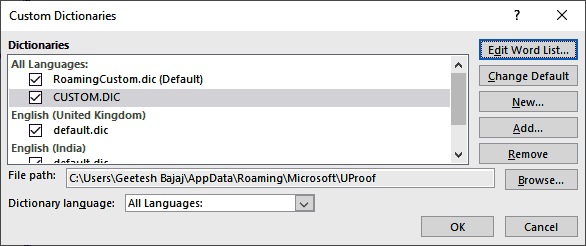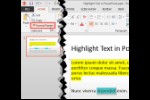Has it ever happened that you knew that a particular word is misspelled, but PowerPoint's spell check doesn't seem to think so! That may be because your word may be in all CAPS, or it may contain some numbers. In these cases, and several other similar instances, PowerPoint ignores some misspellings. Fortunately, you can turn off the options that instruct PowerPoint to ignore these misspellings. Remember though that changing these options will apply to all Microsoft Office applications you have installed on your computer including Word, Excel, and Outlook.
Follow these step to set up spell check options in PowerPoint 365 for windows:
- If you have launched PowerPoint, choose Options, as shown highlighted in green within Figure 1, below. Alternatively, if you already have a presentation open, choose the File menu to bring up Backstage view, and select Options.

Figure 1: Options within the File menu - Doing so opens the PowerPoint Options dialog box. Here, click the Proofing option within the sidebar, highlighted in red within Figure 2, below. You'll see the interface that you can see in Figure 2.

Figure 2: Proofing settings in the PowerPoint Options dialog box - Proofing options within the PowerPoint Options dialog box are explained below, as marked in Figure 2, above. Select or deselect check-boxes as needed:
A. AutoCorrect Options
- Clicking this button brings up the AutoCorrect dialog box, where you can set options for AutoCorrect. Learn more in our AutoCorrect Options in PowerPoint 365 for Windows tutorial.
B. Ignore words in UPPERCASE
- This option is turned on by default and prevents the spell checker from flagging acronyms or any other words typed in ALL CAPS.
C. Ignore words that contain numbers
- This option is turned on by default and ignores spelling errors for words that contain digits, such as license plate numbers or model numbers.
D. Ignore Internet and file addresses
- This option is also turned on by default and prevents the spell checker from flagging web or e-mail addresses, network paths, and file paths.
E. Flag repeated words
- Again, this option is turned on by default and flags second and subsequent instances of the same word in a row, for example preventing you from writing "the the".
F. Enforce accented uppercase in French
- This option is not turned on by default and is only applicable when the editing language is French. It suggests accents for uppercase letters as appropriate.
G. Suggest from main dictionary only
- This option is also not turned on by default. If turned on, it ignores any custom spelling dictionaries you may have created by adding words that you do not consider as misspelled.
H. Custom Dictionaries
- Clicking this button opens the Custom Dictionaries dialog box, shown in Figure 3, below. Here, you can add, remove, enable, disable, or make changes within custom dictionaries. Learn more in our Edit Custom Dictionaries in PowerPoint tutorial.

Figure 3: Custom dictionaries I. French modes
- Use the drop-down list, shown in Figure 4, below, to fine-tune spell check options for French.

Figure 4: French modes drop-down list J. Spanish modes
- Use the drop-down list, as shown in Figure 5, below, to fine-tune spell check for Spanish.

Figure 5: Spanish modes drop-down list K. Check spelling as you type
- This option is enabled by default and performs an automatic spell check and correction as you type. Learn more in our AutoCorrect in PowerPoint 365 for Windows tutorial.
L. Hide spelling and grammar errors
- This option is turned off by default. If enabled, you will disable the red squiggly underlines that automatically appear underneath misspelled words.
M. Frequently confused words
- This option is turned off by default. If enabled, PowerPoint will step in and suggest correction frequently confused words, as shown in Figure 6, below. This setting seems to work best for users who are working with content that's not in their native language. Of course, if you are may not be too happy with PowerPoint trying to understand what you were trying to express. PowerPoint's intervention may also change the context of your sentences. If you are curious, you can enable this option and see if that works for you. If you decide this option is not suitable, you can always turn it off again.

Figure 6: Frequently confused words O. Recheck Document
- This button, when clicked, resets the spelling checker so that PowerPoint will actively recheck words you previously checked and chose to ignore.
- When done, click the OK button, highlighted in green within Figure 2, shown previously on this page, to close the PowerPoint Options dialog box. Any changes you made will be applicable immediately. PowerPoint starts following these changed settings the minute you click the OK button, not only in the active presentation, but also in any presentation you create or edit henceforth. Additionally, these changes will apply to all Microsoft Office programs installed on your computer.
- Save your presentation often.









